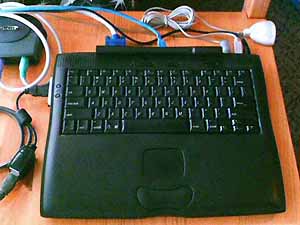I am the proud owner of a PowerBook G3 Series laptop (v2, “PDQ”, released September 1998). The “Wallstreet”, as it is known, was an incredible computer in its day. It was one of the first laptops to have everything you could want in a desktop: a 14.1″ active matrix XGA screen (which was bigger than the 15″ desktop monitors of the time), 3D accelerator, 10 base-T ethernet, SCSI, CD-ROM, 56K modem, integrated number-pad, dual-monitor support, TV-out and a PII trouncing G3 processor. Unfortunately in May 2004, one of the screen hinges broke. I was expecting this dreadful event to occur just like it had for many other Wallstreet owners.

Before this time I had bought a new (lighter) G4 PowerBook and was not using the Wallstreet as a portable. Since it must be run with its lid open, there was no room available on my desk to use it with my KVM setup (it wasn’t getting a lot of use). When the hinge broke, and I discovered that the cost of the repair was several times the value of the computer, I wondered if it would run without any lid at all! So I hooked up an external monitor, powered it up, and sat back waiting for the dreaded chime of death (the way in which Macs cry out in pain). I was pleasantly surprised when it booted seamlessly. (It booted in mirror mode. I later switched it to use the external monitor only.)

The PowerBook now lives squished between two shelves that are about 5cm apart. It is hooked to a PS/2 KVM via a generic USB PCMCIA card and Belkin USB-to-PS/2 adapter. An Apple PlainTalk Microphone replaces the one located in its lid. The computer runs as if its screen and microphone were still attached. Running from an external monitor is flawless (it correctly recalls the last monitor and mode used and applies this at startup). The only catch is the lack of a power button on my PS/2 keyboard, and the fact that the said keyboard and PS/2 mouse fail to wake the machine when it’s “asleep”. This means that I have to reach between the shelves for the power button to turn it on, or any key to wake it up. There is also a 10 second wait for the mouse and keyboard to start responding after the computer has been awakened.
If you’ve any questions about this setup, don’t hesitate to ask.